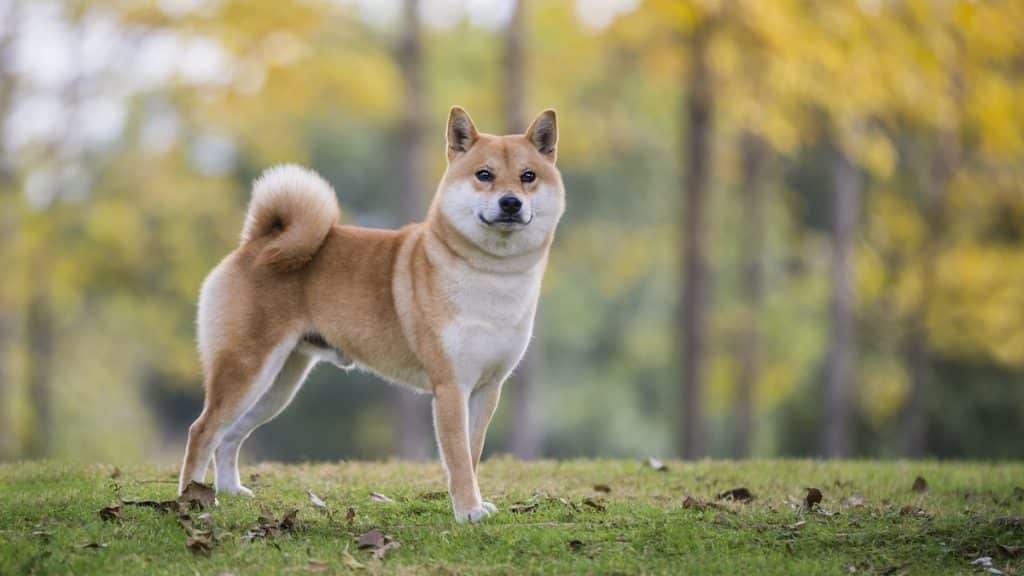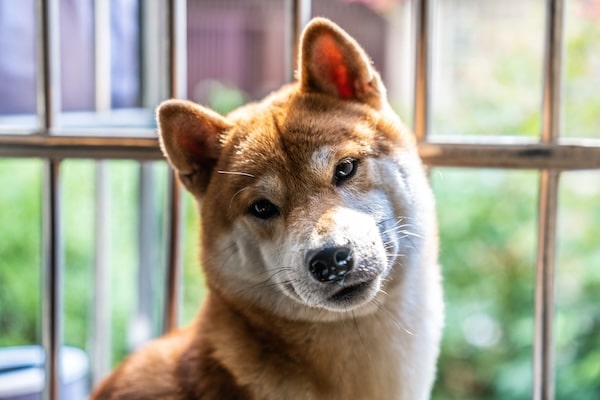
Once bred in the mountains of Japan to hunt small game, the Shiba Inu, which translates to “brushwood dog,” has evolved into a devoted companion. While you might recognize the Shiba as the face of Dogecoin and many internet memes, there is far more to this breed than just a cute face.
“Shibas are highly intelligent, independent dogs. Some would even call them cat-like,” says Jeri Burnside, Public Education Committee Liaison of the National Shiba Club of America. With over 30 years of experience in responsible breeding, showing, and rescuing the breed, Burnside notes that while Shibas may be strongly bonded to their guardians, they are often wary of strangers.
However, how affectionate your Shiba will be depends on each individual pup, Burnside explains. “Some are cuddly lap dogs while others tend to be more reserved, asking for affection on their own terms.”
Shibas thrive in a structured home environment with regular exercise, mental stimulation, and a confident guardian who respects their independent nature. If you’re considering bringing home a Shiba Inu, here are a few other things to know.
Key Breed Characteristics & Facts
Independent and strong-willed, Shibas have a mind of their own. These medium, fox-like dogs tend to be standoffish with strangers but deeply loyal to and affectionate with those they trust.
The average Shiba stands between 13 and 17 inches, with males being slightly taller than females.
Shibas typically weigh between 17 and 23 pounds, making them a great medium-sized dog.
Shiba Inus fall into the non-sporting category. Many dogs in this group are keen watchdogs and loving domestic companions.
This breed can also have white markings known as “urajiro” around the face, chest, legs, and tail.
The Shiba’s beautiful double coat sheds moderately throughout the year and blows out seasonally when they lose their undercoat.
Shibas are active and alert, with moderate to high energy levels. They enjoy daily exercise and mental stimulation but also appreciate quiet time at home.
“Shibas bark, but only for a good reason,” says Burnside. “If my Shiba is alerting me to something by barking, I’ve learned I’d best get up to see what’s happening.” When startled or unhappy, these generally quiet dogs are also known to “Shiba scream.”
While the strong and independent Shiba Inu temperament can make training a challenge, these dogs are incredibly smart.
A healthy Shiba Inu can live a relatively long life for a medium-sized dog, with an average lifespan of 13 to 16 years.
Potential health risks for Shibas include hip dysplasia, patella luxation (slipping kneecaps), and eye disorders.
“Some get along very well with other dogs, while others prefer being the only dog in the home,” shares Burnside. “They have a strong sense of personal space and may not welcome all other dogs into it.”
Physical Characteristics
You won’t miss a Shiba when you see one. These gorgeous dogs have a fox-like appearance with pointy ears, a lean body, and a cute curly-Q tail. Sometimes, they can even look like a little bear! The Shiba Inu size is a solid medium. They generally stand 13 to 17 inches tall and weigh 17 to 23 pounds in adulthood.
Their short, stiff double coat comes in several breed-standard colors, including red, black and tan, cream, and sesame. The whitish or cream-colored markings on the Shiba’s face, chest, legs, and tail are known as “urajiro.” Shibas are seasonal shedders. Although they shed moderately throughout the year, they’re known for blowing their coat heavily twice a year.
Breed History
Originally bred in Japan to hunt game, such as birds and rabbits, the Shiba Inu is an intelligent, independent, and agile breed. Their small but sturdy size and quick reflexes made them an ideal dog for navigating rough, mountainous terrain.
While no longer used as hunting dogs, Burnside notes that it’s not uncommon for Shibas to enjoy chasing rodents, birds, squirrels, and even skunks in the backyard. Over the years, Shibas have evolved into a popular canine companion that benefits from structured training and mental stimulation to satisfy their hunter instincts.
The American Akita, also known as the Akita Inu, is another breed from Japan. Akitas and Shiba Inus are both part of the Spitz family and share many similar physical traits. However, Akitas are far larger than Shibas, weighing up to 130 pounds. They also tend to have a more protective and territorial nature.
Known as Nihon Ken, there are six traditional dog breeds native to Japan: the Shiba Inu, Akita, Kai Ken, Kishu Ken, Shikoku, and Hokkaido. Each breed has its own unique set of traits, but they all boast adorable, pointy ears and a fox-like or bear-like face.
Temperament & Personality
“Shibas don’t have a Golden Retriever attitude of being eager to please at all times,” says Burnside. “The Shiba attitude is more akin to ‘what’s in it for me?’ and is very reward- and food-motivated.” While the cat-like independence of a Shiba Inu may come across as stand-offish, these canines can be very affectionate and loving to people they trust.
Burnside suggests using “early and often” as your motto for Shiba socialization. Given their tendency to be wary of new people and pets, it’s essential to expose them to varied experiences in a positive way early on. Prioritizing handling is also a must, with Burnside recommending getting them used to having their ears, paws, and mouth touched and groomed from puppyhood.
But even the best-laid training plans will only go so far when genetics are at play. And for Shibas, that means implementing management to curb their wild ways. “Even a well-trained Shiba may never achieve 100% reliability off-leash due to their independence and high prey drive,” he notes. “We recommend not allowing a Shiba off-lead in an unenclosed area for this reason.”
A leash also comes in handy, as Shibas are known to get zoomies when excited, particularly after they go potty.

Health & Lifespan
A healthy Shiba can live up to 16 years of age. “Shibas are a generally very healthy breed and often live well into their mid-teens,” says Burnside. “However, some of the hereditary conditions found in many dog breeds can also occur in Shibas.” These include allergies, eye conditions, patella luxation, and hip dysplasia.
When working with a breeder, Burnside recommends confirming that both parents of the puppy (in addition to other relatives, such as grandparents) have completed recommended breed screenings. Trustworthy breeders will submit these results to the Orthopedic Foundation for Animals (OFA) and receive an assigned Canine Health Information Center (CHIC) number for their dog.
Shibas are particularly susceptible to Canine Atopic Dermatitis, a skin disease that causes excessive itching and inflammation.
Experts recommend having your Shiba’s eye pressure checked when they’re about 4 or 5 years old. Shibas are prone to eye diseases, particularly glaucoma, which occurs when fluid in the eye is unable to drain, resulting in increased eye pressure.
Shibas are known for dislocating their kneecap, and there are many ways to help minimize this injury. Regular screenings to check for patellar luxation are key.
X-rays are recommended to check for hip dysplasia, especially if your Shiba is experiencing stiffness or pain in their hind legs.
Care & Maintenance
Don’t be fooled by their aloof nature; Shiba Inus still require plenty of attention through socialization, training, and mental and physical stimulation. Without proper training and adequate enrichment, Burnside warns of destructive or neurotic behavior. “They aren’t a breed that will tolerate long periods of being crated indoors alone or left outside. They need to be where their people are.”
And while their coats don’t require professional grooming, they do need regular upkeep at home. Nail clipping, teeth brushing, and ear cleaning should also start as soon as possible to get the dog acclimated to good hygiene habits.
“Regular combing, brushing, and occasional bathing and blow-drying will help remove a shedding coat or caked-on dirt,” says Burnside. “Since Shibas blow their coat twice a year, this helps remove loose fur.”
“All Shibas love exercise, and access to a large, securely fenced yard is ideal,” says Burnside. For pet parents without a yard, a few daily walks, or equivalent exercise should suffice. Your Shiba’s zoomies will also let you know that you need to take them out.
“[Shibas] learn commands easily, but always reserve the right to decide whether or not to obey them,” says Burnside. Patience and positive reinforcement are key when guiding your Shiba through training.
Shiba Inus have high mental stimulation needs and enjoy puzzles, training, and activities that engage their mind. Working their brilliant brains helps prevent boredom and destructive behaviors.
A Shiba’s diet should include plenty of high-quality protein and fiber that supports healthy digestion. Your vet can help you determine the appropriate portion sizes and food types for your pup.
Ideal Living Environment & Compatibility
Shibas are a versatile breed that can thrive in various living environments as long as you meet their needs. However, one of the primary reasons people rehome Shibas is because they aren’t getting along with other dogs in the household.
One way to combat this is to start puppy socialization as soon as you bring your Shiba Inu home. If you already have a Shiba and want another pet, first see how they interact with other animals before adopting another dog or cat.
“Shibas can tolerate a wide range of climates, from desert to tundra,” says Burnside. “Their coats provide insulating protection from cold temperatures. They do well in warm regions as well, as long as a shaded area with plenty of cool, clean water is available.”
Shiba Inus can live in all types of homes, even apartments and condos, if they get enough exercise. But if you’re planning on letting your Shiba off-leash in your backyard, you’ll need a high-walled, securely fenced yard. Shibas have a reputation for being escape artists, says Burnside.
Hiking, agility, fetch, trick training, nosework, flirt poles, and playing outside are some great ways to engage your Shiba.
Shiba Inus make wonderful family dogs but often don’t do well with being handled roughly by children. However, Burnside says they’ll do just fine with kids whose parents have taught them to treat dogs kindly and respectfully.
Experienced dog guardians are ideal for Shibas due to their strong-willed nature. Yet first-time pet parents can still be successful Shiba guardians as long as they’re motivated to put in the time required, especially if they’ve chosen a pup from a responsible breeder.
Is the Shiba Inu a Good Fit for You?
Shibas thrive with people who understand their need for diligent training and respect for boundaries. They’re a great fit for experienced dog guardians or those willing to learn and invest time in building a strong, trusting relationship.
“If an owner is more sedentary or prefers a couch-potato Shiba, adopting an adult or senior instead of a puppy can be a good option,” Burnside proposes. You’re also more likely to find an older Shiba Inu rescue dog via a shelter or humane society if that’s a route of adoption you’d prefer.
For pet parents who have their hearts set on a Shiba puppy, don’t be surprised if you get put on a waiting list. These dogs are popular. Expect to pay between $1,500 to $3,500. To find a reputable breeder, try contacting the National Shiba Club of America or local Shiba clubs. The AKC Puppy Marketplace also has a list of Shiba breeders who have registered their dogs with the AKC. It will be worth the wait!
Resources
- Non-Sporting Group. AKC. https://www.akc.org/dog-breeds/non-sporting/
- Shiba Inu. AKC. https://www.akc.org/dog-breeds/non-sporting/
- The Silent Thief: Glaucoma. National Shiba Club of America. https://www.shibas.org/newstand/glaucoma.html
- Glimpse into Shiba Inu Microbiome Offers Hope for Treating Canine Atopic Dermatitis. Innovative Veterinary Care Journal. https://ivcjournal.com/glimpse-into-shiba-inu-microbiome-offers-hope-for-treating-canine-atopic-dermatitis/